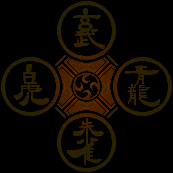 |
Return to Menu
The Real World History of the Bakumatsu
A basic timeline of historical events
| 1853 (Kaei 6) |
Perry's Black Ships Arrive |
On June 3, Commodore Perry sailed four American warships into Uraga, demanding Japan open to foreign trade and access.
On June 12, Perry announced he would return the next year, then withdrew toward China. This marked the start of the Bakumatsu upheavals. Shogun Tokugawa Ieyoshi would pass away that same year. |
| 1854 (Ansei 1) |
Signing of the U.S.-Japan Treaty of Peace and Amity |
On January 16, Perry returned, and Senior Councilor Abe Masahiro yielded to America's gunboat diplomacy.
On March 3, the Treaty of Peace and Amity was signed, opening Hakodate and Shimoda. The shogunate soon signed treaties with Britain, Russia, and other nations as well. |
| 1856 (Ansei 3) |
U.S. Consul General Townsend Harris Arrives |
| On August 5, Townsend Harris was appointed U.S. Consul General to Japan. He set up the consulate at Gyokusen-ji in Shimoda and began talks with the shogunate for a trade treaty. |
| 1858 (Ansei 5) |
Treaty of Amity and Commerce Signed & The Ansei Purge |
On June 19, Ii Naosuke, the great elder at the height of his power, signed the Treaty of Amity and Commerce with the U.S.
In September, pro-imperial activists were arrested in Kyoto, marking the start of the Ansei Purge. |
| 1859 (Ansei 6) |
Yokohama Port Opens |
On June 2, Yokohama was opened to foreign trade, alongside Nagasaki. From then on, Yokohama grew into Japan's gateway to the West.
On October 27, Yoshida Shouin and Hashimoto Sanai (among others) were executed on Ii Naosuke's command. |
| 1860 (Man'en 1) |
The Sakuradamon Incident & The Assassination of Ii Naosuke |
| On March 3, great elder Ii Naosuke was cut down outside Sakuradamon by Mito ronin. With his death, the shogunate's reach and power collapsed almost overnight.
|
| 1862 (Bunkyu 2)
| The Sakasita Gate Incident, the Teradaya Incident, and the Namamugi Incident
|
On January 15, Senior Councilor Andou Nobumasa was ambushed and wounded by Mito rounin outside Sakasita Gate.
On April 23, Shimazu Hisamitsu cut down Arima Shinshichi and others at Fushimi's Teradaya inn. On August 21, Shimazu's procession killed several Britons at Namamugi village.
|
| 1863 (Bunkyu 2)
| The Anglo-Satsuma War and the August 18 Coup
|
On July 2, Britain, frustrated that Satsuma refused to surrender those responsible for the Namamugi Incident, launched the Anglo-Satsuma War.
On August 18, the August 18 Coup: Satsuma allied with Aizu and forced Choushu out of Kyoto politics.
|
| 1864 (Genji 1) |
The Ikedaya Incident: the Shinsengumi take action
Foreign fleets bombard Shimonoseki
|
On June 5, imperial loyalists plotted to burn the Kyoto Imperial Palace and kill officials. The Shinsengumi uncovered the scheme and stormed the conspirators' meeting at the Ikedaya in Sanjou.
On August 5, American, British, French, and Dutch warships bombarded Shimonoseki.
|
| 1865 (Keiou 1) |
Execution of the Mito Tengu Party
Trade treaties with the U.S., Britain, France, and the Netherlands formally approved |
On February 4, the Tengu Party of Mito rose to push for expelling foreigners, but the shogunate branded it treason and executed roughly 400 of them.
On October 5, trade treaties with the U.S., Britain, France, and the Netherlands received the emperor's approval. |
| 1866 (Keiou 2) |
The Satsuma-Choushu Alliance is forged
Tokugawa Yoshinobu becomes the fifteenth shogun |
On January 21, though Satsuma and Choushu were bitter enemies, Sakamoto Ryouma and Nakaoka Shintarou brokered an alliance between them.
On July 20, the 14th shogun Tokugawa Iemochi died of illness, and in December, Tokugawa Yoshinobu became the 15th shogun. |
| 1867 (Keiou 3) |
Tokugawa Yoshinobu restores power to the throne
Sakamoto Ryouma and Nakaoka Shintarou are assassinated |
On October 14, Tokugawa Yoshinobu, the 15th shogun, announced he was returning the shogunate's authority to the emperor, becoming the final shogun.
On November 15, at Shijou in Kyoto, Sakamoto Ryouma and Nakaoka Shintarou were assassinated by the Mimawarigumi police corps. |
| 1868 (Meiji 1)
| The Battle of Toba-Fushimi
The Boshin War begins |
Edo surrendered without a fight, and the city was renamed Tokyo.
On January 3, the Battle of Toba-Fushimi erupted between the shogunate and the Satsuma-Choushu alliance. Yoshinobu fled Osaka Castle and retreated to Edo.
On April 11, Saigou Takamori and Katsu Kaishu agreed to Yoshinobu's surrender, and Edo Castle was handed over peacefully to the new government. |
| 1869 (Meiji 3) |
Surrender of Goryoukaku |
| On May 18, Enomoto Takeaki led former shogunate forces to Ezo to found a Tokugawa state. They fortified Goryoukaku but eventually surrendered to the new government. The Boshin War, begun at Toba-Fushimi, ended with victory for the new government forces.
|
| 1877 (Meiji 10) |
The Satsuma Rebellion and Saigou Takamori's death |
| On February 15, the Satsuma Rebellion erupted. Saigou Takamori, claiming “the government must answer for its actions,” led his rebels from Kagoshima toward Tokyo. After defeat at the Battle of Tabaruzaka, Saigou took his own life on September 24 at Shiroyama in Kagoshima. |
The Timeline of The Last Blade
A basic timeline of historical events
| 1847 |
The Minakata family falls into ruin. Moriya is taken in by Gaisei at six years of age. |
| 1849 |
Gaisei takes in Yuki, who is four years old at the time. |
| 1850 |
Okina asks Gaisei to look after Kaede. |
| 1853 |
Gaisei departs on a training journey to teach Kaede, Moriya, and Yuki. |
| 1854 |
Kagami seals away Shigen and replaces him with a clay puppet. |
| 1858 |
Kagami attacks and kills Gaisei, framing Moriya for the murder.
Kaede, Moriya, and Yuki are thus torn apart.
Okina is driven by Kagami to hide within a barrier, forcing the two into an uneasy balance. |
| 1859-1862 |
Through many upheavals and with the Four Gods absent, the seal on Hell’s Gate weakens, disturbing the harmony between the living world and the land of the dead. |
| 1863 |
The Mannen-Zakura (Ten Thousand-Year Cherry) tree begins to wither, dropping its blossoms.
Lee Rekka arrives in Japan.
Shikyoh leaves the Shinsengumi.
Akari and Juzoh set out on their journey.
Washizuka is sent on a covert mission.
Musashi is resurrected. |
| 1864 |
History moves toward the conclusion of this tale... |
The Four Gods
The eternal guardians who watch over Hell's Gate
The Four Gods are ancient divine beasts said to rule the four directions.
Seiryu guards the east, Byakko the west, Suzaku the south, and Genbu the north.
Each guardian has a natural form: Seiryu as rivers, Byakko as roads, Suzaku as seas and lakes, and Genbu as mountains.
Where the direction and its natural form align is known as a "land of the Four Gods," which is ground believed to be spiritually protected.
This principle, honored in feng shui, has guided city planning, shaping the layouts of places like Heian-kyo and Edo Castle.
In The Last Blade, the Four Gods are portrayed as the keepers of Hell's Gate.
Throughout every age, they have carried this duty forward.
Even if one falls, their place is never left empty; rather, the mantle is passed on to another.
But where does their power truly come from?
It is believed that the supernatural power that maintains balance between the worlds touches those with the right nature (whether in body or spirit), awakening their hidden potential.
|
 |
GENBU
The Black Turtle
Direction: North
Color: Black
Natural Form: Mountains
Element: Water |
 |
BYAKKO
The White Tiger
Direction: West
Color: White
Natural Form: Highways
Element: Gold |
 |
SEIRYU
The Blue Dragon
Direction: East
Color: Blue
Natural Form: Rivers
Element: Lightning |
 |
SUZAKU
The Crimson Phoenix
Direction: South
Color: Red
Natural Form: Seas
Element: Fire |
 |
Onmyoudou ("The Way of Yin and Yang")
A mystical doctrine governing various kinds of magic
Rooted in ancient Chinese philosophy, Onmyoudou blended celestial observation with magic to judge fortune and misfortune. It had developed into a full-blown profession by the 7th century, and its practitioners were called "onmyouji." In Japan, Abe no Seimei is seen as the pinnacle of the art, famed for commanding shikigami and even foretelling the future.
Its base is the yin-yang and five phases doctrine, which classifies all things by yin and yang and by wood, fire, earth, metal, and water, combinations of which could be used to map even space and time. In other words, Onmyoudou also had rigorously systematized "scientific" aspects, ranging from astronomy to geomancy.
Onmyoudou's other primary facet is practical magic, such as talismans, wards, and commanding shikigami to produce tangible effects. Many of Akari's techniques exemplify this, and are possible only through clever use of spirit talismans and fierce spirits. Several of her moves use paper dolls, but wooden figures were also often used.
|
Shinsengumi
The fiercest wolves of Bakumatsu, bound by an iron code
The Shinsengumi were a fighting corps that lived by the sword and made their name feared in the Bakumatsu. Born from a rounin corps of a few dozen, they were tasked primarily with keeping order in Kyoto.
They were bound by a rigorous code that applied even to officers and demanded seppuku for violations. The clause, "Do not betray the warrior's way," was applied broadly: fleeing combat, even if wounded by a sneak attack, could be judged a failure of resolve and punished by death. The code also banned desertion and private fighting.
The Shinsengumi's most famous trio are Commander Kondou Isami, Vice-Commander Hijikata Toshizou, and Okita Souji. Their exploits are retold endlessly in novels, films, and manga. If you want to learn more about them, popular media is a good start, though portrayals vary widely. For accounts grounded in history, it's best to look at scholarly works.
|
The Shinsengumi Code
一、士道に背くまじき事
Article: Never stray from the way of the samurai.
一、局を脱するを許さず
Article: No member may abandon the unit.
一、勝手に金策いたすべからず
Article: Members may not raise funds on their own authority.
一、勝手に訴訟取り扱うべからず
Article: Members may not become involved in legal matters privately.
一、私の闘争を許さず
Article: Personal duels or fights are forbidden.
右条々相背く候者は切腹
Any who break these rules must atone by seppuku.
申付べく候也
Thus it is decreed.
|
Return to Menu
| Source information taken from Gamest Mook #127: ~幕末浪漫~ 月華の剣士 剣技研鑽 (ISBN-13: 978-4881994610) |
| Original Japanese, English, Spanish, and Portuguese text © 1997 SNK |
| All new translation/retranslation © 2025 Jeff Nussbaum and is not for re-use on other sites or publication without express written permission. |
|
 |




